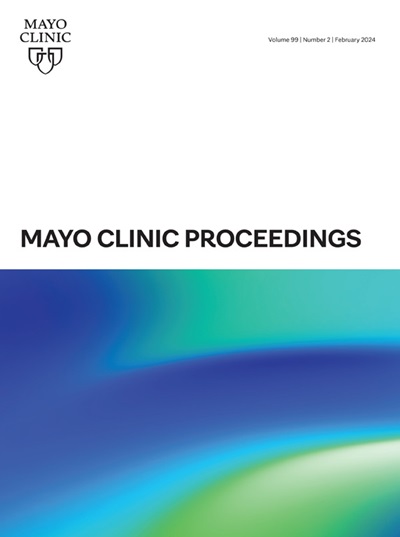Polypharmacy and Potentially Inappropriate Medications in Adults ≥75 Years of Age by Dementia and Frailty Status: The ARIC Study
IF 6.7
2区 医学
Q1 MEDICINE, GENERAL & INTERNAL
引用次数: 0
Abstract
Objective
To estimate the prevalence of polypharmacy (concomitant use of ≥5 medications), hyperpolypharmacy (≥10 medications), and potentially inappropriate medication (PIM) use among older adults according to dementia and frailty status.
Patients and Methods
Cross-sectional data (2016-2017) from 3912 participants aged 71 to 94 years (mean ± SD, 79.6±4.8 years; 59.2% female; 24.5% Black race) from the community-based Atherosclerosis Risk in Communities (ARIC) study were used. Dementia and mild cognitive impairment status was based on comprehensive neurocognitive assessment, informant interviews, and adjudication by an expert panel. Participants were classified as frail, prefrail, or robust according to the Fried frailty phenotype definition. Medication containers were brought to the clinic. The PIMs were defined using a modified version of the Beers Criteria.
Results
Polypharmacy, hyperpolypharmacy, and PIM use were prevalent in 67.1%, 18.8%, and 23.9% of participants, respectively, and 7.9% were classified as having dementia and 8.0% as frail. The demographic-adjusted relative risk ratio (95% CI) for participants with dementia vs normal cognition was 1.79 (1.27 to 2.51) for hyperpolypharmacy, and the odds ratio (95% CI) for PIM use was 1.58 (1.21 to 2.06). The relative risk ratios (95% CIs) for hyperpolypharmacy were 8.35 (5.57 to 12.54) for frail and 2.70 (2.14 to 3.41) for prefrail compared with robust.
Conclusion
Polypharmacy, hyperpolypharmacy, and PIM use were common in this community-based sample of adults approximately 80 years old. These patterns of use were even more common among participants with dementia and frailty, who are at elevated risk for adverse outcomes.
ARIC研究:75岁以上痴呆和虚弱状态的成年人使用多种药物和可能不适当的药物
目的:评估老年人根据痴呆和虚弱状态使用多种药物(同时使用≥5种药物)、过度使用多种药物(≥10种药物)和潜在不适当药物(PIM)的患病率。患者和方法:横断面数据(2016-2017)来自3912名71 - 94岁的参与者(平均±SD, 79.6±4.8岁;59.2%的女性;24.5%黑人)来自社区动脉粥样硬化风险(ARIC)研究。痴呆和轻度认知障碍状态是基于综合的神经认知评估、信息者访谈和专家小组的裁决。根据弗里德脆弱表型定义,参与者被分类为虚弱,虚弱或健壮。药箱被送到了诊所。pim使用比尔斯标准的修改版本来定义。结果:67.1%、18.8%和23.9%的参与者普遍使用多种药物、过度多种药物和PIM,其中7.9%被归类为痴呆,8.0%被归类为体弱。老年痴呆患者与认知正常患者的人口统计学调整相对风险比(95% CI)为多药组为1.79(1.27至2.51),使用PIM组的优势比(95% CI)为1.58(1.21至2.06)。与健全人相比,过度多药的相对风险比(95% ci)为8.35(5.57至12.54),体弱者为2.70(2.14至3.41)。结论:在这个以社区为基础的大约80岁的成年人样本中,多种药物、过度药物和PIM的使用是常见的。这些使用模式在患有痴呆症和体弱多病的参与者中更为常见,他们出现不良后果的风险较高。
本文章由计算机程序翻译,如有差异,请以英文原文为准。
求助全文
约1分钟内获得全文
求助全文
来源期刊

Mayo Clinic proceedings
医学-医学:内科
CiteScore
16.80
自引率
1.10%
发文量
383
审稿时长
37 days
期刊介绍:
Mayo Clinic Proceedings is a premier peer-reviewed clinical journal in general medicine. Sponsored by Mayo Clinic, it is one of the most widely read and highly cited scientific publications for physicians. Since 1926, Mayo Clinic Proceedings has continuously published articles that focus on clinical medicine and support the professional and educational needs of its readers. The journal welcomes submissions from authors worldwide and includes Nobel-prize-winning research in its content. With an Impact Factor of 8.9, Mayo Clinic Proceedings is ranked #20 out of 167 journals in the Medicine, General and Internal category, placing it in the top 12% of these journals. It invites manuscripts on clinical and laboratory medicine, health care policy and economics, medical education and ethics, and related topics.
 求助内容:
求助内容: 应助结果提醒方式:
应助结果提醒方式:


